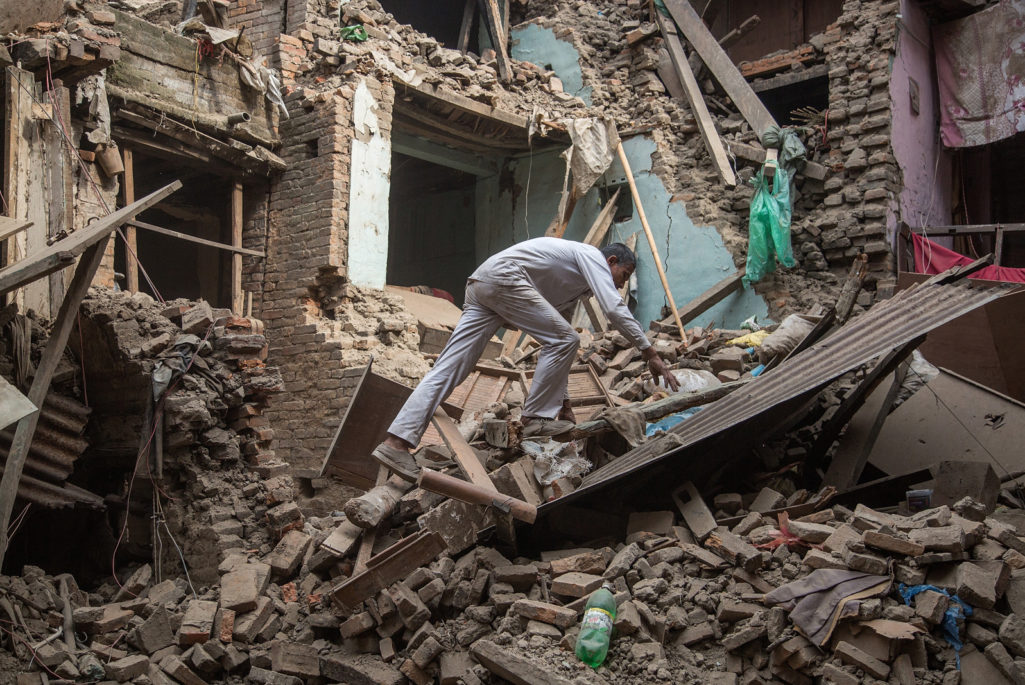
Many houses, buildings and temples in the capital were destroyed during the 7.8 magnitude earthquake in Nepal, leaving thousands dead or trapped under the debris as emergency rescue workers attempt to clear debris and find survivors.
Photo by Omar Havana/Getty Images
Massive piles of wood and debris replace historic monuments in Katmandu’s Basantapur Durbar Square, a centuries-old site ravaged by the magnitude 7.8 earthquake that struck Nepal April 25. Following the earthquake, more than 4,000 rescue workers from 34 different nations traveled to Nepal in order to provide relief. While there are no clear cost estimates required to rebuild Nepal, it is clear the rebuilding effort ahead will be is massive.
“In two to three weeks a serious reconstruction package needs to be developed, where we’ll need enormous help from the international community,” said Information Minister Minendra Rijal. “There’s a huge, huge funding gap.”
BRINK spoke with Elizabeth Hausler Strand, the Founder and CEO of Build Change, about the challenges that Nepal faces following the earthquake and the ways in which the private sector can prevent such large-scale damage in the future.
What are the biggest challenges Nepal faces following the earthquake?
The nation is quickly transitioning from the emergency phase to the recovery phase. Though there is still a significant humanitarian need and crisis, my comments are related mostly to challenges related to rebuilding and reconstruction. These may include mobilizing enough skilled engineers, architects, and other construction professionals to assess buildings, design disaster-resistant new buildings and retrofits, and oversee their construction.
There is also a need to manage the aid money raised in a way that builds resilience and meets the end user’s needs, while mitigating opportunities for corruption. It is more effective in the long term to invest in permanent solutions–permanent housing, retrofitting damaged buildings, permanent schools–than transitional or temporary solutions. It’s more effective to build local capacity and create local jobs than bring in help from outside. The nation also needs to reach rural areas with knowledge, technology, and financing to rebuild safely.
How do the challenges facing Nepal differ from past disasters?
Each disaster has its own unique challenges and opportunities. At this point my guess is that Nepal will face similar challenges to other disasters, and has the benefit of building off those lessons learned.
Are you aware of any disaster-resistant projects that were already in place in Nepal?
Take a look at this image. On the left side, there are collapsed, older, unreinforced stone masonry buildings with weak mortar, heavy roofs. We have known for decades that unreinforced masonry buildings with weak walls and a heavy roof are deadly in earthquakes. This lesson is not unique to this earthquake.
On the right, behind where it says “hot shower,” appears to be a newer building, but with stronger masonry with cement-based mortar, and a lightweight roof. From this view, this building appears undamaged.
The Nepalese have been well aware of the seismic hazard and have been encouraging safe construction for many years. As we move past the immediate humanitarian tragedy in Nepal and the media focus on collapsed buildings, I expect we will see an increasing number of stories about buildings that survived the earthquake and performed well. Initiatives such as NSET, Nepal’s National Society for Earthquake Technology, promote earthquake-resistant building in Nepal.
The private sector is becoming increasingly involved in prevention and building resilience.
Does it take something like a major disaster to spark the private sector’s interest in relief aid?
Though the answer to that question is still yes, change is happening. In addition to providing relief aid, the private sector is becoming increasingly involved in prevention and building resilience, in collaboration with other sectors. This is happening through initiatives such as R!SE, the Microinsurance Venture Incubator recently launched by Marsh and McLennan and other companies, the Rockefeller Foundation 100 Resilient Cities which includes many private sector partners. There are also individuals promoting the private sector involvement in building resilience. Aris Papadopoulos does a great job of explaining this in his recently released e-book, Resilience: The Ultimate Sustainability.
Building long-term resilience and preventing this type of disaster from happening is going to take increasing collaboration from the private sector, government, NGOs, and end users. We’re all going to have to work together with everyone’s best interest in mind to prevent such a disaster from happening in the future.
For a broader look at the role the private sector can play in rebuilding their communities in disaster relief, read Strand’s piece in the World Economic Forum’s Agenda blog.
This interview has been edited for clarity and length.



